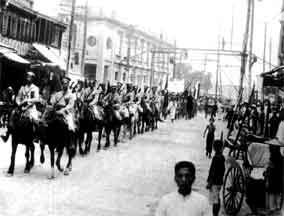1930 Chiang Kai-Shek Attacks
Chiang Kai-Shek begins the first of five military campaigns against the Communists. In the first campaign, he moved against Communists in southern Kiangsi and in parts of Fukein and Hunan provinces..
.
In 1930, Chiang Kai-Shek, the leader of the Chinese Nationalist Party (Kuomintang or KMT), launched a series of military campaigns known as the "Encirclement Campaigns" against the Chinese Communist Party (CCP). These campaigns aimed to suppress the growing influence and power of the Communists, who were establishing themselves in various regions across China.
The Encirclement Campaigns can be divided into five main phases:
-
First Encirclement Campaign (1930-1931): The first campaign was launched against the Jiangxi Soviet, a Communist-controlled area in southeastern China. The Nationalists utilized a strategy of encirclement and gradual advance, but the Red Army, led by Mao Zedong, used guerrilla warfare tactics to counter this approach. Ultimately, the Communists successfully resisted the Nationalist forces.
-
Second Encirclement Campaign (1931): The second campaign followed shortly after the first and targeted the same Jiangxi Soviet region. The Nationalists increased their forces and focused on cutting off the Red Army's supply lines. However, the Communists once again successfully repelled the Nationalist forces using their guerrilla tactics.
-
Third Encirclement Campaign (1931): The third campaign was a brief and unsuccessful attempt by the Nationalists to crush the Communists in the Jiangxi Soviet. This effort was quickly repelled by the Red Army.
-
Fourth Encirclement Campaign (1932-1933): In this campaign, the Nationalists deployed more advanced tactics and weaponry, including air support. Despite the increased pressure, the Communists managed to hold their ground and resist the Nationalist forces once again.
-
Fifth Encirclement Campaign (1933-1934): The final and most extensive campaign involved the deployment of around 1 million Nationalist troops, led by Chiang Kai-Shek himself. The Nationalists adopted a new strategy called the "blockhouse strategy," which involved building heavily fortified blockhouses around the Communist base. Despite the overwhelming odds, the Communists held out until October 1934, when they decided to evacuate the Jiangxi Soviet and embarked on the Long March, a strategic retreat covering over 6,000 miles.
The Encirclement Campaigns ultimately failed to destroy the Chinese Communist Party, and the Long March allowed the Red Army to regroup and expand its influence throughout China. These events played a crucial role in shaping the Chinese Civil War, which continued until the Communists' ultimate victory in 1949.
 >
>